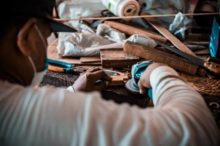On Tuesday 6 and Wednesday 7 October the annual meeting of the Platform for Living Wage Financials (PLWF) took place. Financial institutions, NGOs and representatives from the garment and food, agri & retail industries discussed the impact that COVID-19 has had on their industries and workers in low-wage countries in particular. Their main conclusion for the garment sector: living wage for workers in the clothing industry is still not self-evident, while the need for this is greater than ever.
New research: living wage not yet in sight
On the first, the PLWF presented new research on living wages in the garment industry in which 29 garment companies participated this year.
Irina van der Sluijs (senior human rights advisor ASN Bank and co-initiator of the PLWF) is moderately positive about this year’s results. “Garment companies’ efforts to ensure a living wage remained in the same phase of development or saw some minor improvement. That is a good achievement, also because we applied more rigid assessment criteria. However, many garment companies lack clear targets and a strategy to actually implement a living wage and better working conditions. Instead, we find a patchwork of projects that do not contribute to a higher goal. Garment companies’ actions are mostly limited to a reference to ‘payment of the minimum wage’.”
COVID-19: severe blow to the garment industry
With the emergence of the coronavirus crisis in the first quarter of 2020, both buyers at garment companies and manufacturers had to adapt quickly to a severe loss of consumer demand. The vast majority of workers in the supply chain were left with little to no income. Arthur van Mansvelt (senior engagement specialist Achmea Investment Management): “The fact that the monthly pay of most of these workers is insufficient to allow them to save means they have effectively been hit twice as hard. Added to this heavy load, many needed to put their health at risk to find new ways of income.”
Call on garment industry and financial institutions
The PLWF calls on garment companies to implement a living wage for textile workers in their production chains – on the one hand by fine-tuning their policies and policy choices, on the other by measuring how much their efforts actually contribute to better working conditions and by transparently reporting on this. The platform has developed a methodology to support garment companies in this.
In addition, the PLWF urges financial institutions to consider the social aspects of investment policies and to conduct ‘meaningful engagement’. Karlijn van Lierop (Director Responsible Investment & Governance MN): “Let’s engage in a way we can make a real impact. This means: conduct your own research, have a long breath, collaborate, set milestones and divest where progress stagnates.”
Living incomes in the food, agri & retail sectors
The PLWF expanded its focus in 2019 to include the food & agri sector and food retail. Platform members have engaged with 21 companies to discuss the implementation of living wages and incomes in international coffee and cocoa chains. These discussions and the assessments of these companies show that major steps are still needed to achieve this.
We therefore urge companies to include an express commitment to living wages and incomes in their policies. To this end, it is important they will gain a better understanding of the living conditions of workers in their supply chains and collect large-scale information about this. At present they often confine themselves to a mere reference to minimum wages or industry standards. Finally, it is crucial to scale up projects aimed at ensuring living wages and incomes wherever possible.
Extent of the problem
Lower wages are particularly prevalent in sectors requiring a lot of manual labour, such as textile and footwear, consumer electronics, agriculture or retail. The relative simplicity of the work and the unskilled or low-skilled labour required mean there is much supply on the production side, putting manufacturers (e.g. in Bangladesh, Myanmar and Cambodia) in a very weak negotiating position, especially in times of economic decline. Factory workers in low-wage countries are often unable to meet their basic needs, such as food, clothing, healthcare, housing and education, and generally have no protection against dismissal or access to a social safety net. As a result, many of them end up directly in poverty.
Living wage: catalyst for a better life
A living wage enables workers and their families to meet their basic needs and break the vicious circle of poverty that has kept countless families in its grip for generations. As such, it serves as a catalyst for a better life and prevents child labour and excessive working hours.
About the Platform for Living Wage Financials
Established by ASN Bank, MN and Triodos IM, the Platform for Living Wage Financials currently has 15 members together holding more than 2.6 trillion euros in assets under management. Their common goal is that all investee companies will in due course enable living wages and incomes for workers in their supply chains. The PLWF supports them in their efforts in accordance with the UN Guiding Principles on Business and Human Rights (UNGPs): from living wage policies to practical solutions and measurable impact in the production countries.







